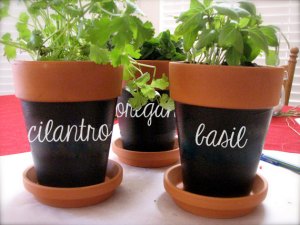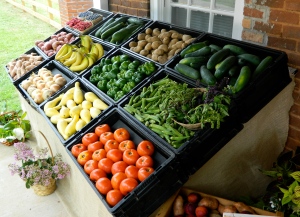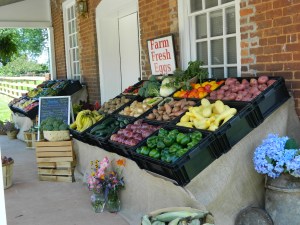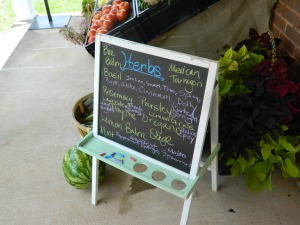
It's that time of year where the daylilies are the showoffs of the garden. Daylilies (Hemerocallis) are a very common perennial in the South. The heirloom or native daylilies grow wild in ditches, railroad tracks and in beds placed lovingly by gardeners long ago. They propagate very easily through division and are a prime starter plant for people who don’t have a green thumb, as well as those interested in learning how to hybridize plants.
 Daylily Division
Daylily Division
To divide a daylily, just dig up the clump and rinse the roots off. Dig a few inches around the diameter of the foliage. You can then see where the plant can be easily spilt, by looking at the root system. Each little bulbular tuber will be a new plant. Gently pull apart the tubers/roots and the top growth. The last step it to replant it, add your compost or fertilizer and you're done!
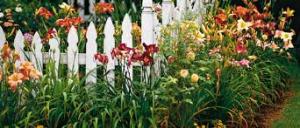 Care
Care
Daylilies are extremely tough plants and require very little maintenance. They like full sun, so plant them in a sunny spot for all to enjoy!
Daylilies need water. Not only do weeds detract from the visual beauty of your garden, but they compete with daylilies for water. This is especially important in times of low rainfall. A simple fact- weeds use a tremendous amount of moisture, in addition to competing for nutrients and sunlight.
Some daylily hobbyists prefer to soak received plants for a couple of hours in water before planting, and they sometimes add a mild root stimulator (some brand of vitamin B) or even a pesticide or fungicide as a preventative measure. (An ounce of prevention is worth a pound of cure.) However, many commercial sellers treat plants with pesticides and/or fungicides before they ship. Therefore, before treating new plants with either, you probably should first check to see if it has already been done.
Once a new acquisition has been planted, you should withhold watering for about two weeks. Natural rain is fine - but do not apply supplemental water. Daylilies take up most of their water from fine root hairs. Transplanted daylilies need a little time to redevelop these fine hairs that were damaged when the plant was dug up.
I have heard of a 'trick' to give new roots a jump start. Plant new daylilies (only those shipped bare root) in just sand (temporarily) or sand-amended dirt (permanently). (I mix sand and compost into all of my plantings.) Planting in sand or a sand/soil blend supposedly promotes faster re-growth of these fine root hairs. Additional watering may be required in such cases, especially if planted in 100% sand, but be careful not to over-water; use a meter if you have one. Avoid planting in midsummer to minimize risk of rot.
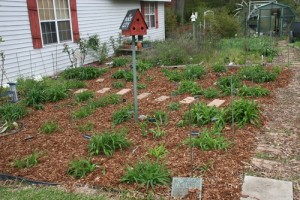 MULCH
MULCH
Despite the fact that mulch can foster the growth of slugs and other insects by providing them with an ideal environment, its benefits outweigh its disadvantages. Mulch can be attractive, practical, and environmentally sound. It controls weeds, retains vital moisture, and provides a use for recycled leaf and grass compost.
Sometimes mulch is used for tender cultivars in winter. Beneficial to many varieties, especially during winters of extremes and rapid climate changes, although hardy cultivars do not need it. Some hobbyists use leaves, shredded, whole, or composted. Some use hay or alfalfa (but these can sprout). (I use compost materials that have not completely broken down and out a layer of pine straw on top.) By 'winter mulch', we are talking about covering the ground only around the daylily leaves and crown, not the actual plant.
 About the Daylily
About the Daylily
The daylily, or more correctly Hemerocallis, is a perennial plant that blooms primarily in midsummer (earlier in the South; later in the far North). The basic plant is often called a 'fan' because the leaves are fan shaped. This means they are arranged in two vertical rows on opposite sides of the 'crown' or core of the plant, similar to an Iris plant. Thus, the leaves tend to grow in one (flat) geometric plane and take on the general shape of an old-fashioned, hand fan. The plant propagates mainly by expanding its roots, which form new fans. A 'clump' is formed as the plant grows and forms multiple fans.
Each individual daylily bloom lasts only one day. Hence, the name from the Greek, meaning beauty for a day. Not all blooms on a given stalk (called a scape) bloom the same day. Daylilies often send up one bloom stalk per fan. Thus, a clump of multiple fans will also usually produce multiple bloom stalks, and each stalk has multiple blooms. Therefore, an individual clump can produce many blooms in total. And because all buds do not bloom on the same day, the plant gives the illusion that the same blooms last for days, even weeks. However, it is simply a different batch of blooms each day, with a single plant having at least some bloom every day generally over a period of 2 to 3 weeks.
Daylily leaves are long and slender. They are varying shades of green. A few ones may show variegation. Yellow indicates trouble: disease or insect infestation.The size of daylily blooms ranges from 1.5 inches (miniatures) to 8 inches or more (the spider varieties). The most common size is 5 to 6 inches.
Daylilies are hybrids. This means that, unlike some other plants, the seeds will not produce exact copies of the mother plant. Thus, you cannot use seed as a means of duplicating your favorite cultivars. As in humans, when you cross two parents, the offspring will exhibit traits of both, but the children will be unique and may not even look like either parent. Therefore, unless you are intentionally hybridizing, do not let seed pods remain on the scape. You would not be using the seed, and the growth of the pod will needlessly steal energy that could be better used to produce more blooms or new fan growth.
Daylilies are a staple of the summer Southern garden, and with so many colors, sizes and even rebloomers, the hardest thing will be to pick just one or three!
Follow us, like us, share us. We are Sweet Basil Farm & Gardens on Facebook. We are a local Middle Georgia producer of farm fresh fruits and vegetables and members of the American Poultry Association, licensed by the Georgia Dept. of Agriculture as Poultry Dealers and Brokers, and a proud member of the Georgia Grown program, a division of the Georgia Dept. of Agriculture. We also breed, sell and ship poultry, pet pigs, bearded irises and much more. We have an 80 acre working farm, with great emphasis on all natural gardening and livestock management practices. An 1840s general store is situated on our property, and serves as our on-site farmer’s market. We have a large vegetable and herb garden, fruit orchards and more. Conveniently located off of Interstate 75 near the Johnstonville Rd exit (#193). We are six miles west, located in Barnesville, Lamar County, Georgia.
Special thanks to growingthehomegarden.com for the fantastic blog ideas, daylillies.org for the diagram and helpful information and the beautiful photo credits to Sweet Basil Farm and others found on Google, and to J. David Matthews, of Barnesville, Ga. for contributions with all that I try and test (and need help planting.)

 It's that time of year where the daylilies are the showoffs of the garden. Daylilies (Hemerocallis) are a very common perennial in the South. The heirloom or native daylilies grow wild in ditches, railroad tracks and in beds placed lovingly by gardeners long ago. They propagate very easily through division and are a prime starter plant for people who don’t have a green thumb, as well as those interested in learning how to hybridize plants.
It's that time of year where the daylilies are the showoffs of the garden. Daylilies (Hemerocallis) are a very common perennial in the South. The heirloom or native daylilies grow wild in ditches, railroad tracks and in beds placed lovingly by gardeners long ago. They propagate very easily through division and are a prime starter plant for people who don’t have a green thumb, as well as those interested in learning how to hybridize plants.




